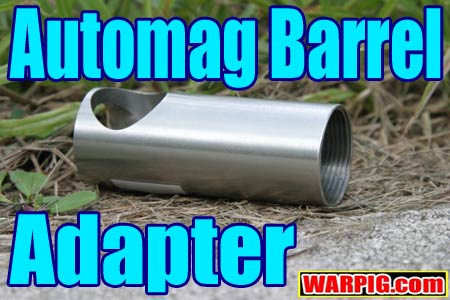  |
|
|
|
|
|
|
  |
|
|
|
|
|
|

What
do you think?
|

Doc’s Automag Barrel Adapter By Bill Mills - October 2003 In the mid 1990s upper level tournament paintballers usually shot one of two paintguns – the Autococker or the Automag. Aside from functioning in completely different ways, the two paintguns also utilized entirely different barrel mounting systems. While the Autococker used a threaded, screw in barrel, the Automag was equipped with a twist lock system that allowed the barrel to be removed much faster. Additionally, the breech of an Automag is built into the barrel, meaning that pulling out the barrel provides complete access for cleaning in case of a ball break.
From AGD’s perspective there is an entirely different reason to change lock systems. With the twist lock barrels, the inner diameter of the breech of an aftermarket barrel is out of their control. Bodies which have the breech as part of the receiver (like AGD’s X-Mag and ULE bodies) all have the same breech diameter, so the specifications for bolt diameter and fit can minimize blowback and maximize gas efficiency. Over the years a number of people have proposed Automag thread adapters, to convert an Autococker barrel to twist lock into an Automag. Some airsmiths said it wouldn’t work because the barrel would unscrew from the adapter during the twist lock process. Then Barrett “Doc” Nickel took up the challenge. Doc is a machinist and airsmith in Kenai, Alaska. In the late 90s, Doc built a reputation as a genuinely helpful guy in WARPIG’s Tech Talk forums, and because of his knowledge and willingness to help, soon developed a customer following as well. Presently, Doc does business under the name “Doc’s Machine” and has gained new notoriety as the author and illustrator of The Whiteboard weekly web comic, and host of the Tinker’s Guild forum on his web site.
The adapter, which is really a breech meant to fit inside the Automag utilizes a single rubber like nubbin. Should this nubbin wear out, it is easily replaced. It is a standard Spyder nubbin that has been modified by having it’s end cut off. Spyder nubbins are available through most paintball shops at a cost under $2. Replacements don’t even need to be cut, they will wear to the proper length.
With the sight rail off, and the body removed from the RT, it was time to install the adapter. The unit ships with a piece of clear tape holding the nubbin in place to prevent loss. The instructions recommend using Dow 33 Shocker Lube to keep the nubbin from binding on the ‘Mag body. WDP’s Love Juice grease seemed to do the job just as well. A tip not found in the instruction manual was to install the adapter by screwing it onto a barrel. This allowed the barrel to act as a handle, making it easy to slide and rotate the adapter into place through the long front end of the RT body, and would be similarly handy with a Minimag body.
Powering the RT with an AGD Flatline air system, it performed well with barrels from Smart Parts, DYE Precision and J&J Performance. None showed any ill effects from the adapter’s use. The RT used for testing had an Airgun Designs Level 10 bolt kit installed. While it was not a problem during testing for review, the vibration of a stock Automag bolt might cause a barrel to unscrew from the adapter during use. It was found that a thin o-ring around the neck of the barrel helped to lock it in place, and should alleviate any fears of the barrel backing out. After an easy install and reliable performance, the real question this adapter brings to mind is, “why didn’t anyone do this earlier?”
|
| Copyright © 1992-2019
Corinthian Media Services. WARPIG's webmasters can be reached through our feedback form. All articles and images are copyrighted and may not be redistributed without the written permission of their original creators and Corinthian Media Services. The WARPIG paintball page is a collection of information and pointers to sources from around the internet and other locations. As such, Corinthian Media Services makes no claims to the trustworthiness or reliability of said information. The information contained in, and referenced by WARPIG, should not be used as a substitute for safety information from trained professionals in the paintball industry. |